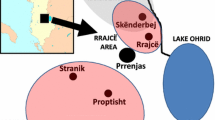Abstract
Detailed observations on the consumption ofVernonia amygdalina (Del.), a naturally occurring plant of known ethnomedicinal value, by an adult female chimpanzee (Pan troglodytes schweinfurthii) of M-group in the Mahale Mountains, Tanzania were made. Chewing the pith of several shoots, she sucked out and swallowed the astringent, bitter tasting juice; spitting out the fibrous remains. The female was followed during this period for 11 hr, over two consecutive days, and was recognized to be in irregular health at the time of consumption, exhibiting signs of lethargy, lack of appetite, and irregularity of bodily excretions. The low frequency and lack of seasonality in the usage of this plant suggest that it is sought after for reasons other than as a food source. These factors suggest that for chimpanzees, the consumption of this plant is primarily medicinal. The symptoms displayed by the female are the same as those experienced by people throughout tropical Africa who utilize this plant as a medicinal treatment for them. Interactions between the female and others suggest that they too were aware of her condition and coordinated their activities with the female and her infant.
Similar content being viewed by others
References
Altmann, J., 1974. Observational study of behavior; Sampling methods.Behaviour, 49: 227–267.
Burkill, H. M., 1985.The Useful Plants of West Tropical Africa. (2nd ed.) Vol. 1, Royal Botanic Gardens, Kew.
Cambefort, J. P., 1981. A comparative study of culturally transmitted patterns of feeding habits in the chacma baboon (Papio ursinus) and the vervet monkey (Cercopithecus aethiops).Folia Primatol., 36: 243–263.
Dalziel, J. M., 1937.The Useful Plants of West Tropical Africa. Appendix toFlora of West Tropical Africa,J. Hutchinson &J. M. Dalziel (eds.), Whitefriars Press Ltd., London.
Githens, T. S., 1949.Drug Plants of Africa. Univ. of Pennsylvania Press, Philadelphia.
Goodall, J., 1986.The Chimpanzees of Gombe; Patterns of Behavior. The Belknap Press of Harvard Univ. Press, Cambridge.
Hamilton, W. J., III, R. E. Buskirk, &W. H. Buskirk, 1978. Omnivority and utilization of food resources by chacma baboons,Papio ursinus.Amer. Naturalist, 112: 911–924.
Hiraiwa-Hasegawa, M. &T. Hasegawa, 1988. A case of offspring disertion by a female chimpanzee and the behavioral changes of the abandoned offspring.Primates, 29: 319–330.
————, ————, &T. Nishida, 1984. Demographic study of a large-sized unit group of chimpanzees in the Mahale Mountains, Tanzania: A preliminary report.Primates, 25: 401–413.
Irvine, F. R., 1961.Woody Plants of Ghana, Oxford Univ. Press, London.
Itani, J., 1958. On the acquisition and propagation of a new food habit in the natural groups of the wild Japanese monkey at Takasakiyama.Primates, 1: 84–98. (in Japanese)
Janzen, D. H., 1978. Complications in interpreting the chemical defense of trees against tropical arboreal plant-eating vertebrates. In:The Ecology of Arboreal Folivores,G. G. Montgomery (ed.), Smithsonian Inst. Press, Washington, D.C., pp. 73–84.
Kalmus, H., 1970. The sense of taste of chimpanzees and primates. In:The Chimpanzees, Vol. 2,G. H. Bourne (ed.) Karger, Basael, pp. 130–141.
Kokwaro, J. O., 1976.Medicinal Plants of East Africa. General Printers Ltd., Nairobi.
Nishida, T., 1979. The social structure of chimpanzees of the Mahale Mountains. In:The Great Apes: Perspectives on Human Evolution, Vol. 5,D. A. Hamburg &E. R. McCown (eds.), Benjamin/Cummings, Menlo Park, pp. 73–121.
————, 1987. Learning and cultural transmission in non-human primates. In:Primate Societies,B. B. Smuts,D. Cheney,R. Seyfarth,R. W. Wrangham, &T. Struhsaker (eds.), The Univ. of Chicago Press, Chicago, pp. 462–474.
———— &S. Uehara, 1981. Kitongwe name of plants. A preliminary listing.Afr. Stud. Monogr., 1: 109–131.
———— & ————, 1983. Natural diet of chimpanzees (Pan troglodytes schweinfurthii): long term record from the Mahale Mountains, Tanzania.Afr. Stud. Monogr., 3: 109–130.
————,R. W. Wrangham, J. Goodall, &S. Uehara, 1983. Local differences in plant-feeding habits of chimpanzees between the Mahale Mountains and the Gombe National Park, Tanzania.J. Human Evol., 12: 467–480.
Phillips-Conroy, J. E., 1986. Baboons, diet, and disease: food selection and schistosomiasis. In:Current Perspectives in Primate Social Dynamics,D. M. Taub &F. A. King (eds.), Van Nostrand Reinhold, New York, pp. 287–304.
Revusky, S., 1984. Associative predispositions. In:The Biology of Learning,P. Marler &H. S. Terrace (eds.), Springer-Verlag, Berlin, pp. 447–460.
Rewell, R. E., 1969. Intestinal infections. In:The Chimpanzees, Vol. 1,G. H. Bourne (ed.), Karger, Basel, pp. 425–458.
Richter, K., 1943. Total self-regulatory functions in animals and human beings.Harvey Lecture Series XXXVIII.
Rodriguez, E., M. Aregullin, T. Nishida, S. Uehara, R. W. Wrangham, Z. Abramowski, A. Finlayson, &G. H. N. Towers, 1985. Thiarubine-A, a bioactive constituent ofAspilia (Asteraceae) consumed by wild chimpanzees.Experientia, 41: 419–420.
Rozin, P., 1977. The significance of learning mechanisms in food selection: some biology, psychology and sociology of science. In:Learning Mechanisms in Food Selection,L. M. Barker,M. R. Best, &M. Domjan (eds.), Baylor Univ. Press, Waco, pp. 557–593.
————, &J. W. Kalat, 1971. Specific hungers and poison avoidance as adaptive specializations of learning.Psychol. Rev., 78(6): 459–486.
Takahata, Y., M. Hiraiwa-Hasegawa, H. Takasaki, &R. Nyundo, 1986. Newly acquired feeding habits among the chimpanzees of the Mahale Mountains National Park, Tanzania.Human Evol., 1(3): 277–284.
Takasaki, H. &K. Hunt, 1987. Further medicinal plant consumption in wild chimpanzees?Afr. Stud. Monogr., 8(2): 125–128.
Uehara, S. &R. Nyundo, 1983. One observed case of temporary adoption of an infant by unrelated nulliparous females among wild chimpanzees in the Mahale Mountains, Tanzania.Primates, 24: 456–466.
Watt, J. M. &M. G. Breyer-Brandwijk, 1962.The Medicinal and Poisonous Plants of Southern and Eastern Africa. E. & S. Livingston Ltd., Edinburgh.
Wrangham, R. W., 1975. The Behavioural ecology of chimpanzees in Gombe National Park, Tanzania. Ph.D. dissertation, Univ. of Cambridge, Cambridge.
———— &T. Nishida, 1983.Aspilia spp. leaves: A puzzle in the feeding behavior of wild chimpanzees.Primates, 24: 277–282.
Author information
Authors and Affiliations
About this article
Cite this article
Huffman, M.A., Seifu, M. Observations on the illness and consumption of a possibly medicinal plantVernonia amygdalina (Del.), by a wild chimpanzee in the Mahale Mountains National Park, Tanzania. Primates 30, 51–63 (1989). https://doi.org/10.1007/BF02381210
Received:
Accepted:
Issue Date:
DOI: https://doi.org/10.1007/BF02381210



